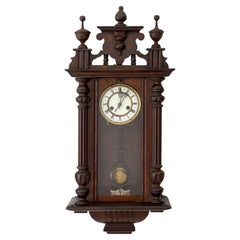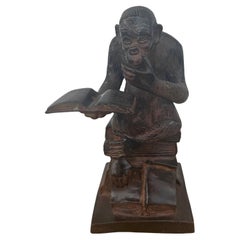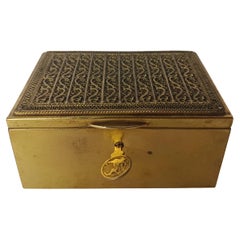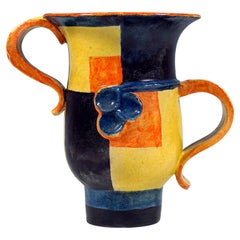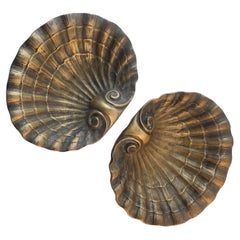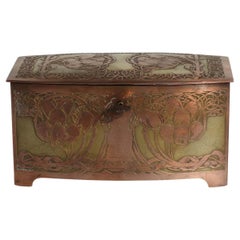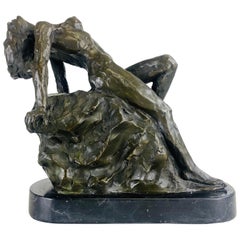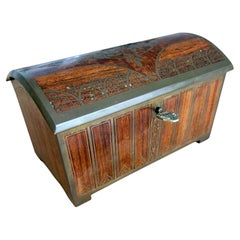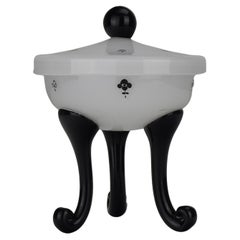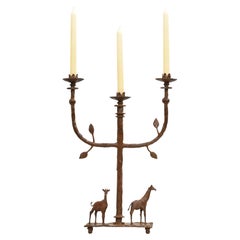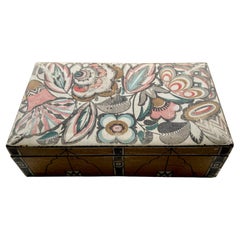Expressionist Decorative Objects
to
30
127
25
5
7
120
30
60
27
23
15
10
7
4
2
2
3
6
2
8
26,278
14,189
9,256
5,449
3,962
3,079
2,288
1,734
1,416
1,339
1,156
1,151
1,023
934
890
675
655
593
94
57
40
19
17
79
37
101
56
24
23
21
Height
to
Width
to
157
135
146
18
8
4
3
3
Style: Expressionist
1900 Erhard and Sohne Secessionist Jugendstil Art Nouveau Copper Brass Case
Located in Brescia, IT
Jugendstil Box Set
Germany, 1900-1909
Copper and Brass Casket
Floral decoration
Complete with key
Marcho embossed under the base
Rare item
Excellent state of preservation
Category
Early 1900s German Antique Expressionist Decorative Objects
Materials
Brass, Copper
Dynamic female nude sculpture by Auguste Rodin
Located in Allentown, PA
This is a dynamic female nude sculpture by Auguste Rodin. This suggestive sculpture is beautifully executed in the impressionist style. This museum restrike stands on a black marble ...
Category
1970s Unknown Vintage Expressionist Decorative Objects
Materials
Bronze
Arts & Crafts Jewelry Box Casket by Erhard & Sohne, Vienna Secession w. Dome Top
Located in Lisse, NL
Stunning and great condition, brass Secessionist box with amazing inlay and the original key.
There are -for good reasons- collectors of the Vienne...
Category
Early 20th Century Austrian Expressionist Decorative Objects
Materials
Brass
Bohemian Enamelled Loetz White Tango Glass Box and Cover by Dagobert Peche
Located in Bad Säckingen, DE
Rare white tango box and cover by Loetz enameled with black stylized flowers and black feet and lid finial designed by Dagobert Peche c.1915.
Category
1910s Austrian Vintage Expressionist Decorative Objects
Materials
Glass, Art Glass, Blown Glass, Opaline Glass
$756 Sale Price
20% Off
Sculptural Bronze Giraffe Candelabra
Located in Pretoria, Gauteng
This handcrafted bronze candelabra celebrates the quiet elegance and harmony of Africa’s wildlife. Each piece is entirely original — no moulds are used at any stage. Every giraffe an...
Category
2010s South African Expressionist Decorative Objects
Materials
Bronze
Emanuel josef Margold, a secessionist box for the Bahlsen cookie factory c. 1915
Located in London, Fitzrovia
A rare rectangular shaped box with a hinge cover; tinplate, gilt and with beautiful colourful abstract floral motifs.
The bottom is embossed with ‘H. Bahlsens Keks-Fabrik Hannover Königl-Preuss-Staatsmedaille Weltausstellungen - 1904 1910 Grosser Preis 1911 1913 Baltische Ausstellung Malmö 1914 Die Königl. Medaille’
Bahlsen's new designs for ornamental giftware packaging were shown at the exhibition held by the Deutsche Werkbund...
Category
20th Century German Expressionist Decorative Objects
Materials
Tin
Ernst Barlach Plaster 'Russian Peasant Woman and Child'
Located in Sharon, CT
An extremely rare 'preparation painted' for casting model by the great German 'Gothic' Expressionist Ernst Barlach (1870-1938). These sculptures date from young Barlach's 1906 visit ...
Category
Early 20th Century German Expressionist Decorative Objects
Materials
Plaster
Peter Max Pop Art Ceramic Ashtray by Iroquois
Located in San Diego, CA
A very cool Peter Max pop art ceramic ashtray by Iroquois of Syracuse, NY, circa 1980s. There are three different ashtrays available; all are in excell...
Category
Late 20th Century American Expressionist Decorative Objects
Materials
Ceramic
$340 Sale Price / item
20% Off
Austrian Cold Painted Bronze Owl Sculpture. Bergmann 1900´s
Located in Buenos Aires, Olivos
Austrian Cold Painted Bronze Owl Sculpture. Bergmann 1900´s.
Early 20th century, Bergmann Bronze Sculpture.
An Austrian cold painted bronze model of an Owl.
The body naturalisticall...
Category
Early 20th Century Austrian Expressionist Decorative Objects
Materials
Bronze
Josef Hoffmann Black Gitterwerk Waste Basket or Umbrella Stand for Bieffeplast
Located in Troy, MI
Josef Hoffmann hexagonal wastebasket or umbrella stand
Originally designed in 1905, edition Bieffeplast circa 1980s
Gitterwerk structure in black perforated steel with original lab...
Category
Late 20th Century Italian Expressionist Decorative Objects
Materials
Metal, Steel
1930s French Antique Lifesize Children Sculptures in Bronze Finish
By Charles Albert Despiau
Located in New York, NY
France, early 20th century.
Pair of two lifesize sculptures, brother and sister, the boy sitting cross-legged and the girl on a stump holding a pla...
Category
1930s French Vintage Expressionist Decorative Objects
Materials
Plaster
$11,800 Sale Price / set
41% Off
LOVE, Bronze Sculpture by Norma Goldberg Dated 1977
Located in Los Angeles, CA
Beautiful bronze sculpture of 2 nude males embracing titled LOVE by Norma Goldberg, dated 1977
The piece can really communicate the love this couple ...
Category
Mid-20th Century American Expressionist Decorative Objects
Materials
Bronze
A Continental Arts & Crafts Oak Mantle Clock with Carved Stylised Glasgow Roses
Located in London, GB
A Continental Secession style Arts & Crafts oak mantle clock stepped top a silvered dial behind a full length door with bevelled glass flanked by two pairs ...
Category
Early 1900s European Antique Expressionist Decorative Objects
Materials
Oak
Masai Girl - African Bronze Sculpture
Located in Pretoria, Gauteng
A Maasai girl, upon reaching adolescence, undergoes a traditional rite of passage known as "Enkipaata" a ceremony marking her transition into womanhood and preparing her for the resp...
Category
2010s South African Expressionist Decorative Objects
Materials
Sandstone, Bronze
Monumental Horse Sculpture Equestrian Decor 1960s Lifelike Expressionist Art
By Charles Marion Russell
Located in Peoria, AZ
MAGNIFICENT
HORSE HEAD
PLASTER SCULPTURE!
BOLD! BOLD! BOLD!
SUPERB DETAILS!
In the Manner of Charles Marion Russell
(DIMENSIONS: Approx. 13" x 5" x 16" )
CIRCA 1960s
This m...
Category
Mid-20th Century American Expressionist Decorative Objects
Materials
Plaster
$2,160 Sale Price
38% Off
Unique Low Cabinet with Intarsia by Viktor Lurje for Wiener Werkstätte c. 1926
By Wiener Werkstätte, Viktor Lurje
Located in Berlin, DE
Unique low cabinet with intarsia designed by the architect, artist and craftsman Viktor Lurje (1883-1944) and manufactured by Wiener Werkstätte GmbH, circa 1926. Together with Oskar ...
Category
1920s Austrian Vintage Expressionist Decorative Objects
Materials
Wood
Vienna Secession glazed earthenware vase, Austria, ca. 1902
Located in EVERDINGEN, NL
An octagonal green and blue earthenware vase with blue glazed squares, marked Austria and numbered 7143. These type of vases were made in the Vienna School of Applied Arts (Wiener Ku...
Category
Early 1900s Austrian Antique Expressionist Decorative Objects
Materials
Earthenware
$2,057 Sale Price
20% Off
Bohemian Loetz Red Tango Glass Vase w. Black Accents by Michael Powolny
Located in Bad Säckingen, DE
This antique Art Nouveau art glass vase by Michael Powolny for Loetz is an impressive and highly sought-after art piece from the early 20th cen...
Category
1910s Austrian Vintage Expressionist Decorative Objects
Materials
Glass, Art Glass, Blown Glass
$1,148 Sale Price
20% Off
Mid-Century Modern Abstract Expressionist Sculptural Bust by Bedford, USA
Located in Deland, FL
Entropy a compelling and unique bust by American Ceramic Arist, Bedford, c. 1960's. Expertly handcrafted earthenware, stains, oxides. "I use the word entropy as a metaphor for change...
Category
1960s American Vintage Expressionist Decorative Objects
Materials
Clay
Expressionist Cast Bronze Bust
Located in Kilmarnock, VA
A powerful 20th-century cast bronze Expressionist bust, imbued with raw psychological energy and sculptural immediacy. Evocative of The Scream by Edvard Munch, the distorted features...
Category
20th Century Unknown Expressionist Decorative Objects
Materials
Bronze
Jewelry Box Erhard und Söhne
Located in Buenos Aires, Argentina
Jewelry Box
Erhard und Söhne
Gilt bronze
Origin: Germany
Features their logo on the (original) key and base
Blue tapestry interior
Impeccable condition
Filigree decoration with geome...
Category
1930s German Vintage Expressionist Decorative Objects
Materials
Bronze
Studio art ceramic contrapposto vessel, early aughts
Located in View Park, CA
A unique studio art ceramic vessel featuring an unusual bombastic contrapposto stance with bulging belly, signed, early aughts. In deep licorice with hints of iridescent aubergine an...
Category
21st Century and Contemporary Unknown Expressionist Decorative Objects
Materials
Ceramic
$96 Sale Price
40% Off
Cubist Style Bronze Sculpture Signed by Jim Bass & Titled Homage to Nancy Keith
Located in Topeka, KS
Magnificent 2002 Cubist style bronze sculpture signed by Jim Bass titled “Homage to Nancy Keith.” This is # 2 of 8 editions, mounted on a rectangular walnut base. Beautiful condition...
Category
Early 2000s American Expressionist Decorative Objects
Materials
Bronze
Painted Porcelain and Hand Carved, Gold Leaf Wood Frame, Signed "Épanouissement"
By Angelo Asti
Located in Buenos Aires, Buenos Aires
Painted porcelain and hand carved, gold leaf wood frame, signed "Épanouissement", Vienna, circa 1890.
Category
Late 19th Century Austrian Antique Expressionist Decorative Objects
Materials
Gold Leaf
Bronze Rhino Bust Sculpture
Located in Pretoria, Gauteng
The Black Rhino is one of Africa’s most formidable creatures, yet also among its most vulnerable. This bronze bust, finished in a deep blue verdigris patina, captures the raw strength and weathered dignity of the rhino’s head, its horn thrust forward like a spear forged by evolution. I first sketched this piece in the field when all I could see was a rhino’s head emerging through the thicket—an unforgettable impression of power and presence.
The rhino’s horn, once its ultimate defense, has tragically become the very reason for its decline. In this sculpture, that paradox is frozen in bronze: resilience and fragility bound together. Set on a sandstone base, the piece is both a tribute and a reminder—of nature’s grandeur and mankind’s responsibility to protect it.
Black Rhino Bust, Bronze Rhino Sculpture...
Category
2010s South African Expressionist Decorative Objects
Materials
Bronze
Charming Hand-Carved Wooden Sculpture of a Man with Toothache, Signed 'K.R.'
Located in Lisse, NL
Man with toothache, head wrapped in cloth.
This expressive and whimsical wooden sculpture captures a universally relatable moment: a man suffering from a toothache. The figure leans...
Category
Early 20th Century European Expressionist Decorative Objects
Materials
Wood, Pine
Huge Cold-Painted Bronze entitled Standing Stage by Franz Bergmann. 1900´s
Located in Buenos Aires, Olivos
Large Impressive cold painted Austrian bronze study of a standing stag / Deer, with intricate detail and very fine color.
Additional information
Height: 34 cm
Depth: 8.5 cm
Width: ...
Category
Early 20th Century Austrian Expressionist Decorative Objects
Materials
Bronze
Austrian Secessionist Enameled Basket, 1900
Located in Saint-Amans-des-Cots, FR
Secessionist basket, Austria, 1900. Metal & glass. Enameled garlands of roses. Measures: width : 8.1"(20.5cm), depth : 2.4"6cm), height: 3.4" (8.7cm). Just small traces of age on...
Category
Early 1900s Austrian Antique Expressionist Decorative Objects
Materials
Metal
Judy Brady Sculpted Ceramic Head
Located in Bloomfield Hills, MI
The UNTITLED portrait sculpture has a quiet yet powerful and commanding aura. The viewer cannot be around or near it without feeling its presence. It has a very classical approach in...
Category
1970s American Vintage Expressionist Decorative Objects
Materials
Ceramic, Paint
Vase Amphora Austria Art Nouveau Bohemia Teplitz Ceramics Secessionist
Located in Bad Säckingen, DE
This large and unusual floral hand-decorated double-handled ceramic vase by Ampora Turn-Teplitz showcases the characteristic artistic sensibilities of the Art Nouveau Vienna Secessio...
Category
Early 1900s Austrian Antique Expressionist Decorative Objects
Materials
Ceramic
$756 Sale Price
20% Off
Antique Austrian Venetian Filigree Ormolu Gilt Bronze Jewelry Box Circa 1900
Located in Moreno Valley, CA
Antique Austrian Ormolu Jewelry Box Circa 1900.
A beautifully decorated jewelry box in an ormolu case and lined with an aubergine velvet interior....
Category
Late 19th Century Austrian Antique Expressionist Decorative Objects
Materials
Bronze
Pablo Picasso Pichet Têtes Pitcher
Located in Los Angeles, CA
Earthenware pitcher by Pablo Picasso 1950's edition. The pitcher features two different figures on each side of the pitcher, in both a black oxidized and white glaze.
Dimensions
6.5...
Category
Mid-20th Century Unknown Expressionist Decorative Objects
Materials
Earthenware
Elisabetta Mayo d’Aloisio, L’Eterno Padre, Bronze Bust, Italian, c. 1930s
By Elisabetta Mayo D’Aloisio
Located in Morristown, NJ
Elisabetta Mayo d’Aloisio, L’Eterno Padre, Bronze Bust, Italian, c. 1930s, on Marble Base
Description
A commanding and emotionally charged bronze sculpture by Elisabetta Mayo d’Aloi...
Category
1930s Italian Vintage Expressionist Decorative Objects
Materials
Marble, Bronze
Theater Mask by Wolfgang Utzt in treated Leather for the Play "Ragtime", 1992
Located in Berlin, DE
This striking theater mask by German artist Wolfgang Utzt was crafted in 1992 for a production of the play Ragtime. Expertly formed from treated leather, the mask embodies Utzt’s dis...
Category
1990s German Expressionist Decorative Objects
Materials
Leather, Beech
$5,647 Sale Price
20% Off
Vienna secession jewelry box atr. Dagobert Peche for Wiener Werkstätte
Located in Banská Štiavnica, SK
Vienna secession jewelry box atr. Dagobert Peche for Wiener Werkstätte in excellent original condition.
Category
1910s Austrian Vintage Expressionist Decorative Objects
Materials
Brass
Alfred Arthur Brunel de Neuville, "Hot Milk"
By Alfred Arthur Brunel De Neuville
Located in Ottawa, Ontario
Alfred Arthur Brunel de Neuville (French 1852-1941), the painting is titled "Hot Milk", signed 'Brunel Neuville' (lower right), oil on panel, framed. The panel measures 12 3/16" inch...
Category
Late 19th Century French Antique Expressionist Decorative Objects
Materials
Paint
Surrealist Ceramic Face Sculpture
Located in Houston, TX
Surrealist Ceramic Face Sculpture.
Offered is an unusual textured ceramic sculpture in the Surrealist style. This shapely abstract surrealist sculpture has many faces on it and appea...
Category
20th Century North American Expressionist Decorative Objects
Materials
Ceramic
Italian 19th Century Carrara Marble Sculpture of a Boy by Raffaele Belliazzi
By Raffaele Belliazzi
Located in Los Angeles, CA
A very fine Italian 19th century carved carrara marble sculpture Group Titled "LA GIOIA NELL'INNOCENZA DOPO IL LAVORO" (The Joy of Innocence After Labour) by Professor Raffaele Belliazzi (Italian, 1835-1917). The slender figure of the young boy, seated and resting on a rock with his hanging legs crossed and joyfully eating a cluster of grapes picked from his hat that is resting on his lap. The intricate carving of his shirt, jacket, pants, hat and boots with fine attention details such at the stitching, buttons, the hem on his pants, the wear on the soles of his boots and the features on his face makes this one of Belliazzi's finest known works. The sculpure rests on a dark green serpentine marble pedestal with a rotating top. Signed: Profor. Belliazzi, Carrara. Florence, circa 1870-1880.
It may be possible to identify the present marble sculpture of a boy eating grapes...
Category
19th Century Italian Antique Expressionist Decorative Objects
Materials
Marble, Carrara Marble
$58,950 Sale Price
30% Off
Zulu Warrior Sculpture in Bronze Verdigris - Limited Edition Bronze Sculpture
Located in Pretoria, Gauteng
Zulu warriors were renowned for their disciplined formations and innovative tactics in battle, epitomized by the "buffalo horns" strategy developed by the legendary Shaka Zulu: a man...
Category
2010s South African Expressionist Decorative Objects
Materials
Bronze
$1,264 Sale Price
20% Off
Vienna Secessionist Art Glass Vase w/ Copper Overlay, ca. 1910
Located in Petaluma, CA
This lovely little vase is a fine example of the Vienna Secessionist movement. The hand worked copper overlay is all you need to look at to see what I ...
Category
Early 20th Century Expressionist Decorative Objects
Materials
Copper
$247 Sale Price
50% Off
Three Wiener Werkstatte Style Biscuit Tins
Located in Sharon, CT
Three beautifully decorated Austrian/German biscuit or candy tins. The red oval: 8x3.5x5", large square: 8.25x8.25x5.5" and the flower decorated:4.25x8.75x6.75.
Category
Early 20th Century Austrian Expressionist Decorative Objects
Materials
Tin
$1,500 / set
Secessionist Vase, Ruddy Pink with Wiener Werkstatte-Influenced Glyphs
By Wittenberg Pottery
Located in Philadelphia, PA
Clearly showing the influences of the Vienna Secession and the Wiener Werkstatte, at a time when Vienna led the Germanic world's interpretation of Art Nouveau and Art Deco, this cyli...
Category
1920s German Vintage Expressionist Decorative Objects
Materials
Ceramic
$1,080 Sale Price
20% Off
Bronze Sable Antelope Bust - African Antelope Bronze Sculpture - Limited edition
Located in Pretoria, Gauteng
It is hard to forget the first time you see a sable antelope — the glossy black coat, the proud arch of the neck, and those magnificent, scimitar-shaped horns curving gracefully back...
Category
2010s South African Expressionist Decorative Objects
Materials
Bronze
Bronze Elephant Herd Sculpture
Located in Pretoria, Gauteng
Inspired by many years in the bush spent in close study of my Africa's magnificent wildlife, my sculpture endeavours to pay tribute to Africa's wildlife.
This elephant sculpture was...
Category
2010s South African Expressionist Decorative Objects
Materials
Bronze
Zuri - Young Woman, Bronze Abstract Nude - African Sculpture
Located in Pretoria, Gauteng
Zuri, which is beautiful in Swahili, is a Bronze African Abstract Nude and marks a significant moment in my creative evolution—an expansion from sculpting wildlife into exploring the human form. Initially, my art was inspired by Africa’s magnificent wildlife, but over time, the graceful silhouettes of tribal warriors and women—often glimpsed through the blistering summer haze—began to captivate me in a new way. There was something profoundly moving about their presence—dignified, resilient, and quietly powerful. That vision led me to explore the human spirit in bronze. Zuri is an abstract interpretation of that essence: rooted in strength, shaped by grace, and elevated by simplicity. Through her, I seek to honour not just form, but feeling. Bronze sculpture in a rich traditional patina with hints of Verdigris...
Category
2010s South African Expressionist Decorative Objects
Materials
Bronze
$1,271 Sale Price
25% Off
Secessionist Porcelain Vase by Karl Klaus for Serapis Wahliss
Located in Palm Beach, FL
Secessionist Porcelain Lidded Box by KARL KLAUS (1889-1925) for SERAPIS WAHLISS, Vienna, c. 1911, hand-painted in gold and black enamels in a stylized geometric diamond and holly mot...
Category
1910s Austrian Vintage Expressionist Decorative Objects
Materials
Porcelain
Emanuel josef Margold, a small secessionist box for the Bahlsen factory, c.1915
Located in London, Fitzrovia
A nice shaped box with a hinged cover; tinplate, gilt and with beautiful colourful motifs.
The bottom is embossed with ‘H. Bahlsens Keks-Fabrik Hannover Königl-Preuss-Staatsmedaille ...
Category
20th Century German Expressionist Decorative Objects
Materials
Tin
Late 20th C. Expressionist Giacometti-Like Pair of French Bronze Candle Holders
Located in North Miami, FL
Late 20th century Expressionist Giacometti-like pair of french bronze candle holders
By: Diego Giacometti (in the style of)
Material: bro...
Category
Late 20th Century French Expressionist Decorative Objects
Materials
Bronze, Metal, Copper
Created by Hand, Dream like Sea Form in Porcelain
Located in West Palm Beach, FL
Created by a delicate hand, a sampling of our pure white or mixed warm toned porcelain and ceramic sea forms for your table. Each piece and intricate part is created by hand one at a...
Category
2010s American Expressionist Decorative Objects
Materials
Porcelain
Secessionist Clock by Karl Klaus for Serapis Wahliss
Located in Palm Beach, FL
Note: We highly recommend shipping through 1stDibs for its cost effectiveness, full insurance coverage, and reliable handling. While standard parcel services are an option, the default quote does not include packing and insurance. 1stDibs shipping provides a level of value, protection, and care that aligns with our commitment to safeguarding historic artworks and providing excellent client service.
Secessionist Clock...
Category
1910s Austrian Vintage Expressionist Decorative Objects
Materials
Porcelain
Ceramic 'Autumn' Putto by Michael Powolny for Gmundner Keramische Werkstatte
Located in Brisbane, QLD
A large and rare ceramic monochromatic putto holding grapes (Autumn from "The Four Seasons") by Austrian designer Michael Powolny for Gmundner Keramische Werkstatte. First designed b...
Category
1910s Austrian Vintage Expressionist Decorative Objects
Materials
Ceramic
Vienna Secession Silvered Vase by Weiner Werkstatte
Located in Atlanta, GA
A hammered silver plate metal vase attributed to Josef Hoffmann and made by Wiener Werkstatte, circa 1920s. The vase is in the typical style of the Vienna secession, it features a ve...
Category
Early 20th Century Austrian Expressionist Decorative Objects
Materials
Metal
Richard Thuss Austrian Gilt Bronze Figure of an Oriental Woman Dancing
Located in Buenos Aires, Olivos
Oriental Dancer, Jugenstil Vienna bronze sculpture, 1900s
Richard Thuss Austrian Gilt Bronze Figure of an Oriental Woman Dancing
Stamped under a foot VNO. Gilt has been restored. It ...
Category
Early 20th Century Austrian Expressionist Decorative Objects
Materials
Marble, Bronze
Going to the River - African Antelope Bronze Sculpture
Located in Pretoria, Gauteng
A journey in bronze 'Going to the River', features two Kudu Bulls. One of the most recognisable silhouettes of the African bush my latest sculpture pays homage to this magnificent be...
Category
2010s South African Expressionist Decorative Objects
Materials
Bronze
Beginning of the Hunt - Bronze Maasai Warrior Sculpture
Located in Pretoria, Gauteng
This bronze sculpture captures a Maasai warrior in a moment of stillness and anticipation — poised at the very start of the hunt. I was inspired by the elegant silhouettes of tribal ...
Category
2010s South African Expressionist Decorative Objects
Materials
Bronze
Wiener Werkstaette Art Ceramics Expressive Style, Vase, by V. Wieselthier 1927
Located in Vienna, AT
Cylindrical base, vessel above rising in a tulip shape, flared rim, two curved bands applied offset on the sides as handles, three-leaf flowers in relief on the front and back.
Geome...
Category
1920s Austrian Vintage Expressionist Decorative Objects
Materials
Ceramic
Expressionist Ceramic Sculpture Based on "The Cat Butler" by Diego Giacometti
Located in North Miami, FL
Early 20th century Expressionist glazed ceramic sculpture based on "The Cat Butler" by Diego Giacometti
By: Diego Giacometti (in the style of)
...
Category
Early 20th Century French Expressionist Decorative Objects
Materials
Enamel
Josef Hoffmann Style Tiered Tray
Located in London, GB
Josef Hoffmann (style) tiered serving stand, 20th/21st century, goldtone pierced metal, unmarked.
Category
1930s Austrian Vintage Expressionist Decorative Objects
Materials
Brass
Contemporary Italian Murano Glass Silver Gold Colorful Mosaic Panel Sculpture
By Vévé Glass
Located in New York, NY
Contemporary modern Murano Art glass sculpture, a decorative panel displayed on a dark grey iron base, realized as a colorful Mosaic, grey, yellow, burgundy, white and black murrine, aqua blue, amethyst purple glass...
Category
21st Century and Contemporary Italian Expressionist Decorative Objects
Materials
Iron, Gold Leaf, Silver Leaf
Pair of Ceramic Planters Signed Austria, Vienna Secession Period, circa 1900
Located in Buenos Aires, Buenos Aires
Pair of ceramic planters signed Austria. Vienna Secession period, circa 1900.
Category
Early 1900s Austrian Antique Expressionist Decorative Objects
Materials
Ceramic
Expressionist decorative objects for sale on 1stDibs.
Find a broad range of unique Expressionist decorative objects for sale on 1stDibs. Many of these items were first offered in the Late 20th Century, but contemporary artisans have continued to produce works inspired by this style. If you’re looking to add vintage decorative objects created in this style to your space, the works available on 1stDibs include decorative objects, serveware, ceramics, silver and glass and other home furnishings, frequently crafted with ceramic, canvas and other materials. If you’re shopping for used Expressionist decorative objects made in a specific country, there are Europe, Austria, and Spain pieces for sale on 1stDibs. While there are many designers and brands associated with original decorative objects, popular names associated with this style include Peter Keil, Michael Powolny, Vally Wieselthier, and Wiener Werkstätte. It’s true that these talented designers have at times inspired knockoffs, but our experienced specialists have partnered with only top vetted sellers to offer authentic pieces that come with a buyer protection guarantee. Prices for decorative objects differ depending upon multiple factors, including designer, materials, construction methods, condition and provenance. On 1stDibs, the price for these items starts at $120 and tops out at $125,000 while the average work can sell for $2,675.
Still Thinking About These?
All Recently ViewedMore Ways To Browse
Vintage Ceramic Mermaid
Vintage Cologne Bottles
Vintage Copper Decor
Vintage Lion Figurine
Vintage Murano Glass Cat
Vintage Pot Plant Holders
West Germany Yellow
White Horse Porcelain
Wood Ram Sculpture
Wooden Carved Dog
Wooden Cow
1920s Royal Copenhagen
1960 Italy Cats
19th Century Bronze Stag
Acrobats Bronze
Alexandrite Murano
Amsterdam Clock
Antique Bronze Hare
